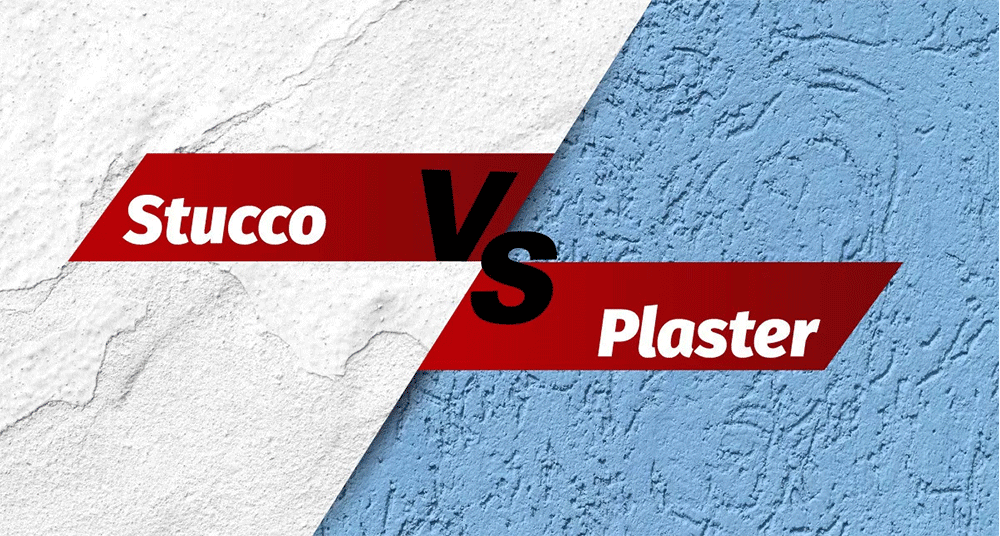Stucco vs. Plaster
Stucco
Stucco is a construction material made of aggregates, a binder, and water. It is applied wet and hardens to a very dense solid. And is used as decorative coating for walls and ceilings, exterior walls, and as sculptural and artistic material in architecture. Stucco can be applied on construction materials. Such as metal, expanded metal lath, concrete, cinder block, or clay brick and adobe for decorative and structural purposes. As a building material, this is a durable, attractive, and weather-resistant wall covering. Stucco is typically applied in one or two thin layers directly over a solid masonry, brick, or stone surface. And the finish coat usually contains an integral color and is typically textured for appearance.

Stucco is a cement-type mixture made of sand, Portland cement, lime, and water. It is considered a thin “finish coat,” the outermost visible layer, and can be painted. Stucco is applied using one of three methods: one-coat, two-coat, and three-coat. They vary by composition, what surfaces they work best with, and speed of completion. One-coat methods are speedier, while three-coat methods are the gold standard and most durable.
Stucco is an exterior home finishing plaster coat found on homes nationwide, thanks to its durability and versatility. It is one of the most durable exterior materials, with a typical life span of 50-100 years or more. Depending on environmental and climate factors. this material provides an excellent seal against rain and snow because it’s seamless, unlike nearly every other form of siding. Stucco walls require the use of a moisture barrier.
If you have stucco on your home or other structure, it can withstand the elements. Including temperature changes, rainstorms, and even hail storms. However, stucco can crack when exposed to extreme temperatures. And even after a few years of exposure to sunlight, it may show signs of weathering. There are two types of stucco patching compounds: the traditional “mud” and pre-mixed versions.
Gypsum role in stucco
Gypsum plays a significant role in stucco as it is one of the main components of gypsum plaster. Which is a type of stucco plaster. Gypsum plaster is a gypsum-based plaster suitable for application on most internal backgrounds, including bricks, blocks, and concrete. It consists of gypsum, aggregates, and water. When dry POP powder is mixed with water, it hardens. And this material can be applied over brick, block, or concrete surfaces to form a smooth surface called gypsum plaster.
Gypsum plaster has good insulation properties, is fire-resistant, and impact-resistant. It also saves a lot of time during construction. And also has high productivity, excellent high strength after drying, and a smooth finish. Gypsum plaster is highly resistant to fire and has low thermal conductivity. Stucco is formed by partial dehydration of gypsum, a naturally occurring mineral. It is important to control this dehydration process to ensure the proper consistency and strength of the stucco. However, gypsum plaster is a type of stucco plaster that uses gypsum as the main component.
Plaster
Plaster is a construction material that is commonly used for interior walls and ceilings. Gypsum plays a crucial role in plaster as it is the main component of gypsum plaster. Which is a type of plaster. Gypsum plaster is a white cementing material made by partial or complete dehydration of the mineral gypsum.
When dry gypsum powder is mixed with water, it hardens. And this material can be applied over block, brick, or concrete surfaces to form a smooth surface called gypsum plaster. Gypsum plaster is widely used in interior construction due to its properties. It offers excellent acoustic and thermal properties while giving leveled walls with the best finish. Gypsum plaster provides a smooth interior finish and is an ideal base for good quality paints and wallpaper finishes. It can be applied on both smooth and rough surfaces of the wall.
Gypsum plaster is easy to apply and requires less skilled manpower unlike the traditional cement mortar. Gypsum plaster is non-combustible and contains high content of crystal water. In the event of fire, it acts like a barrier and protects the block work. Plaster can be made from other materials besides gypsum, such as cement and sand. Plaster is typically used for indoor surfaces and can be applied to decorative purposes and molded into different shapes.
Gypsum role in plaster
Just like stucco, Gypsum plays a crucial role in plaster as it is the main component of gypsum plaster. Which is a type of plaster. Gypsum plaster is a white cementing material made by partial or complete dehydration of the mineral gypsum. When dry gypsum powder is mixed with water, it hardens. And this material can be applied over block, brick, or concrete surfaces to form a smooth surface called gypsum plaster.
Gypsum plaster is widely used in interior construction due to its properties. It offers excellent acoustic and thermal properties while giving leveled walls with the best finish. Gypsum plaster provides a smooth interior finish and is an ideal base for good quality paints and wallpaper finishes. It can be applied on both smooth and rough surfaces of the wall.
Difference between stucco and plaster
Stucco and plaster are both construction materials that contain cement and water. But they have some differences in their composition, use cases, and installation processes. Here are some key differences between stucco and plaster.

Stucco
-Uses Portland cement as the main component.
-Has a lime base.
-Rougher in texture than plaster.
-Typically used for outdoor surfaces.
-More durable than plaster.
-Can only be applied outside.
-Requires fiberglass to make it more rigid for certain applications.
Plaster
-Uses gypsum as the main component.
-Softer than stucco due to its gypsum base.
-Smoother in texture than stucco.
-Can be placed in molds for custom designs.
-Can be applied indoors and outdoors, making it more versatile than stucco.
-Vulnerable to water damage and mold.
-Can be more susceptible to blunt force damage due to its softer surface.

In summary, while stucco and plaster may look similar, they have different material compositions, use cases, and installation processes. Stucco is typically used for outdoor surfaces and is more durable. While plaster is used for interior walls and can be placed in molds for custom designs.
